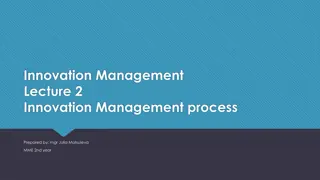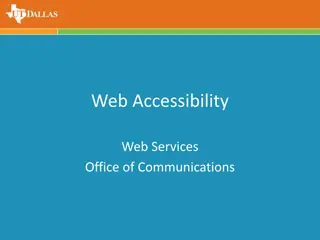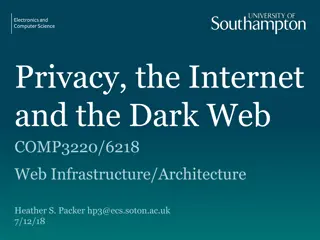Understanding Push-to-Web and Address-Based Online Surveying
Push-to-web surveying entails contacting samples offline and prompting them to complete online questionnaires, capitalizing on cost efficiency, convenience, and modern design elements. Various push-to-web designs employ different contact approaches, incorporating multiple reminders for optimal response rates. In the UK, longitudinal studies like Understanding Society and NCDS utilize push-to-web strategies alongside face-to-face and telephone modes, navigating complexities in data collection and cost savings.
Uploaded on Sep 22, 2024 | 0 Views
Download Presentation

Please find below an Image/Link to download the presentation.
The content on the website is provided AS IS for your information and personal use only. It may not be sold, licensed, or shared on other websites without obtaining consent from the author. Download presentation by click this link. If you encounter any issues during the download, it is possible that the publisher has removed the file from their server.
E N D
Presentation Transcript
PUSH-TO-WEB AND ADDRESS BASED ONLINE SURVEYING (ABOS) Joel Williams, Kantar Public UK November 2017
2 What/why push-to-web What is push-to-web surveying? Sample is contacted offline (by post, by telephone or in-person) and asked to complete a questionnaire online while other response modes are downplayed or offered only after online non-response Why push people to respond online? (In some circumstances) online completions cost less than other types More convenient for some (no need for interview appointments, questionnaire can be done bit by bit) Can use visual prompts (incl. pictures and even video, and dynamic question design) that are logistically difficult to do with paper or by telephone Seems modern (or at least not as antiquated as interviewing)
3 Varieties of push-to-web designs Contact approach depends on what is known about the sampled household or individual Almost always written contact rather than expensive personal contact Contact mode can include mailed letters, emails, SMS text messages, social media posts All available contact modes tend to be used and typical to send 2-3 reminders as most research suggests that maximising the number of contact opportunities maximises the probability of response Some will regard this as bombardment , potentially reducing response probabilities to other modes in the sequence or to future waves of the study (if longitudinal in form) Not much evidence (I ve seen) for negative effects but push-to-web designs are fairly new to social research so absence of evidence should not be taken as evidence of absence!
4 Push-to-web surveys in the UK: longitudinal studies Major longitudinal surveys: Understanding Society (wave 7 onwards) WEB>FTF NCDS (age 55 sweep) WEB>TEL Next Steps (waves 5-8 of original cohort (ages 18, 19, 20, 25) and waves 4-7 of new cohort (17, 18, 19, 20)) WEB>TEL>FTF Mixed-mode studies are more complex to manage than single mode studies and data more complex to use Measurement effects are sometimes substantial which makes causal inference more difficult Data collection cost savings in WEB>FTF designs can be modest because interviewers still travelling to sample areas and have to contact/persuade the harder-to-get cases
5 Push-to-web surveys in the UK: cross-sectional studies Name-based samples Personally addressed contacts no additional sampling, (probably) better chance of response, stronger data safeguards, potential for tailored communications Individual-level data on sample frame opens up responsive design options, powerful weighting strategies E.g. Wellcome Trust Science Education Monitor (aged 14-18), DfE s Pupils & Parents survey Address-based samples Same sparse but comprehensive sample frame as for general population interview surveys Small area data or imputed (pseudo)address level data can be utilised for responsive design Kantar developed this in UK and calls it ABOS Address-Based Online Surveying
6 What is ABOS? Basic design: Stratified random sample of addresses is drawn from the Royal Mail s postcode address file Invitation letter is sent to the residents , containing username(s) and password(s) plus survey website url Device-agnostic questionnaire (nowadays this means designed for mobile) Lots of variants possible! Within-address sampling (take one at random, take all, take up to n?) Reminder communications (letter or postcard? responsive design? evolving message strategy?) Incentives (what value? should they be targeted?) Complementary modes (paper option? separate interview survey?)
7 Example letter from 2016-17 Community Life Survey (upper/lower parts of p1)
8 Why ABOS? Originally conceptualised as lower cost alternative to increasingly difficult dual-frame RDD More flexible with regard to both size and shape than interview surveys Builds upon ABS designs in the US and push-to-web strategies utilised on many surveys First test with face-to-face interview survey Community Life in 2012 (Cabinet Office, now DCMS) Now used as the sole data collection method for Community Life Kantar has used it for six other clients and Ipsos MORI uses a variant for Sport England s Active Lives
9 Questions about ABOS (see also article in SRA Social Research Practice Vol 3) Q1: If the sample is of addresses, how do you convert this into a sample of individuals? Q2: How do you verify that the data is from the sampled individual(s)? Q3: How do you cover offline individuals? Q4: What RR does the ABOS method get and what is the impact of the design features you have tested? Q5: How does response rate vary between subpopulations, and what (if anything) can you do about it? Q6: What evidence do you have for non-response bias? Q7: How much does it cost?
10 Q1: How do you convert a sample of addresses into a sample of individuals? No control over which household in multi-household addresses (but few of these in England) Don t really know who lives in each household (electoral roll is partial/dated; use of other databases restricted) Initially tested quasi-random last/next birthday methods to select respondent but substantial non-compliance ESS/NatCen tested proper random-one sampling but experienced similar problems Tested all individuals method to overcome problem Clustered data but statistical value similar to sample that requires within-household sample weights Lower printing/postage costs Risks of contamination (like most whole-household surveys) and of multiple completions by one resident Community Life estimates are not systematically different under all individuals design than under true random one design
11 Standardised difference in survey estimates between the all-individuals and random-one designs (28 principal variables)
12 Q1: How do you convert a sample of addresses into a sample of individuals? ONS developing a household/person level admin database but not ready yet & use will be highly restricted So new options with postcode address file being tested: Single username/passcode for any individual in household to use Enters household grid data (name, age, gender, relationship data & any other eligibility criteria) Original username/passcode can be used N additional times (N = number of additional eligible individuals) Or new usernames/passcodes generated for each additional eligible individual Option 1: 1st respondent notes them down and passes them on; Option 2: 1st respondent supplies e/m-contact data for these individuals so unique link can be sent directly; Option 3: new letters are posted to each individual (or one randomly sampled)
13 Q2: How do you verify that the data is from the sampled individual(s)? Verification of self-completion survey data must be proportionate to avoid exploding budget Far less control than with interview surveys Strategy 1: Stress the importance of data validity; explain that verification procedures are used (w/o specifying) Strategy 2: Control the release of usernames/passcodes within each sampled household (noted earlier) Strategy 3: Construct algorithm to weed out completed questionnaires that fail on set (multiple) criteria Algorithm based on suggestions from the literature but survey-level identification matrix is unspecified <5% exclusion rate for Community Life; 2-10% on other surveys, depending on edit criteria Live question whether combination of these strategies is sufficient even if it is proportionate (i.e. what is risk to inference of including bad data?)
14 Q3: How do you cover offline individuals? Based on 2015-16 data, 13% of the adult population in GB has not used internet in last 12 months: effectively not covered by an online survey method Shrinking but particularly distinctive with respect to birth cohort and educational level (see chart) Government studies can t usually miss them out!
15 Have you used the Internet at home or elsewhere in the last 12 months? (CSEW, 2015-16)
16 Q3: How do you cover offline individuals? Based on 2015-16 data, 13% of the adult population in GB has not used internet in last 12 months: effectively not covered by an online survey method Shrinking but particularly distinctive with respect to birth cohort and educational level Government studies can t usually miss them out! Most ABOS studies use paper option (usually on request and in selected 2nd reminder packs) Paper brings in different demographic types but will not necessarily improve overall sample balance Paper option enforces simple questionnaire design or version limited to headline measures Alternative is (costly) parallel interview survey limited to offline/not-very-online Impact on total population estimates of alt.mode data not always substantial (see chart) but think about subpopulations too
17 What difference does paper make to the estimates? (example from 2017; paper = 30% of data)
18 Q4: What response rate does the ABOS method get? Response rate depends on sponsor, topic, design features etc. In our experience, has ranged from 7% to 25%+ Conditional incentives increase RR and sometimes pay for themselves through lower printing/postage costs Adding paper questionnaires to one of the reminders is even stronger incentive (but not cheap) Government sponsor clear on envelope! is a major advantage Kantar s current focus is on limiting between-strata variance in response rate Targeting reminder packs that include paper questionnaires is the single most effective tool we have Varying the number of reminders also works well (some evidence for varying type too) Varying message strategy has more limited effect
19 Using paper questionnaires to even up response rates (Community Life 2016-17: online & on-demand paper & targeted paper) (Est) Person-level RR (both modes) (Est) Person-level RR (web only) Stratum (IMD) Method Paper q res in all 2nd reminders Paper q res in all 2nd reminders Paper q res in 60% of 2nd reminders Nopaper q res in reminders Nopaper q res in reminders Most deprived 20% 19% 10% 2nd quintile 22% 12% 3rd quintile 24% 17% 4th quintile Least deprived 20% 21% 20% 24% 23%
20 Q5: How does response rate vary between subpopulations? Online respondents more educated than average and less likely to rent Online response lowest in deprived areas and in other areas with lots of flats Paper questionnaires bring in more people aged 60+ and especially those aged 75+ Probably bring in u60s who have long-term illnesses or disabilities and/or live in social rent accommodation Overall, ABOS profiles less accurate than face-to-face interview (RP) profiles but similar to dual-frame RDD Critical to survey sufficient numbers of each type for multi-dimensional post-stratification to work Modest design effects due to multi-dimensional weighting suggest reasonable raw sample balance Worth assessing weighting efficiency for each marginal subpopulation in the weighting matrix
21 Weighting efficiency for subpopulations (Community Life; ABOS online/paper RR = 22%, paper questionnaires used as secondary mode) Weighting efficiency Weighting variables: Subpopulation Gender*age group Gender Male 80% Highest qualification*age group Female 85% Age group 16-19 20-24 25-29 30-34 35-39 40-44 45-49 50-54 55-59 60-64 65-69 70-74 75+ 93% 95% 92% 87% 86% 86% 88% 87% 85% 82% 87% 91% 95% Housing tenure Household structure Region Ethnic group
22 Weighting efficiency for subpopulations (Financial Lives; ABOS online RR = 7%, f2f interviews used as secondary mode for 70+ and offline 18-69) Weighting efficiency Weighting variables: Subpopulation Gender*age group Gender Male 71% Employment status*age group Female 74% Age group 18-24 25-29 30-34 35-39 40-44 45-49 50-54 55-59 60-64 65-69 70-74 75-79 80+ 64% 83% 82% 83% 81% 84% 82% 69% 63% 68% 60% 68% 76% Highest qualification*age group Housing tenure Household structure Region
23 Q6: What evidence do you have for non-response bias? Most survey data lack benchmarks which makes (non-demographic) bias hard to quantify For some variables, interviews and s/c questionnaires would produce very different distributions from the same sample so high RR surveys are not necessarily suitable benchmarks for ABOS studies Three year parallel run with Community Life provided an opportunity to assess whole system effects System effects of variable size but sometimes large, especially if rating scales used ABOS-style follow-up of interview respondents suggested that most (not all) system effects are due to measurement differences rather than differences in sample characteristics These sorts of study are very valuable when considering a new data collection system like ABOS
24 Scatter-graph of estimated measurement effects (x axis) v system effects (y axis) Community Life
25 Scatter-graph of estimated selection effects (x axis) v system effects (y axis) Community Life
26 Q7: How much does it cost? Specific combination of design features that is adopted will influence cost (of course!) For general population surveys, costs have (so far) been 50-70% of dual-frame RDD and 15-20% of f2f interview surveys but ABOS is much more expensive than (convenience sample) online panel surveys Surveys specifically of subpopulations more expensive per eligible complete but sometimes able to use auxiliary address data to improve efficiency Community Life now incorporates an ethnic minority population boost purely through applying different sample fractions for different strata Potential to use address-level admin data - or data from vendors like Experian/CACI - to improve efficiency Piloting essential due to wide variation in response rates
PUSH-TO-WEB AND ADDRESS BASED ONLINE SURVEYING (ABOS) Joel Williams, Kantar Public UK November 2017

























